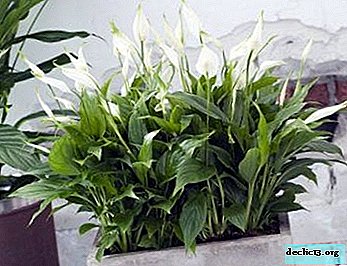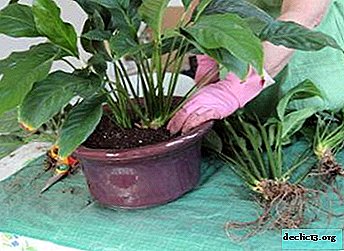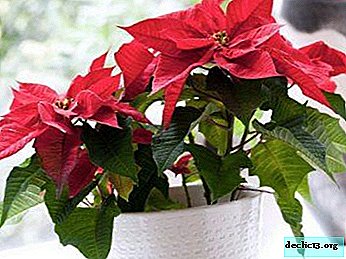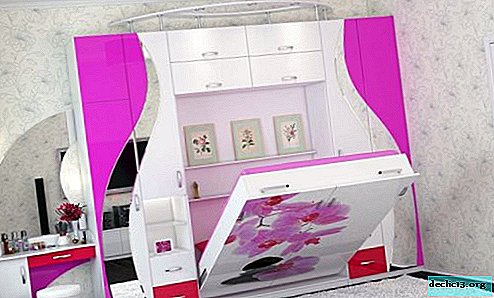Step-by-step instructions on how to transplant purchased spathiphyllum

Spathiphyllum, or "female happiness", is distinguished by spectacular and prolonged flowering.
Caring for this plant is a pleasure. Spathiphyllum is considered not capricious and not difficult to maintain flower.
The most important thing is to properly transplant the plant after purchase and help adapt to new conditions.
To do this, you need to know the individual characteristics of spathiphyllum.
Is a transplant needed and when exactly is it done?
Is it obligatory to do this after the purchase?
15-20 days after the acquisition, it is necessary to transplant spathiphyllum. In the store, the plants are contained in transport peat soil. Such a substrate is not suitable for the further development of the flower.
When to hurry?
The need for an urgent transplant can be determined by the appearance of the spathiphyllum. Such a plant occupies almost the entire volume of the container, leaves are smaller, buds are not formed. This means that the roots completely braided the earthen lump and stopped developing.
Attention! If you do not transplant the flower on time, the process of decay of the root system may begin.When is it better to abstain?
It is not recommended to disturb the blooming spathiphyllum, otherwise the buds will quickly wither. It is better to wait until the flowering process ends.
Step-by-step instructions on how to properly carry out the procedure at home
Soil preparation
 Spathiphyllum loves a friable, slightly acidic substrate that retains moisture well. Soil can be bought in specialized stores. It is necessary to purchase a soil mixture for plants of the Aroid family. Land for flowering plants is also suitable. In this case, add one tenth of sand or perlite.
Spathiphyllum loves a friable, slightly acidic substrate that retains moisture well. Soil can be bought in specialized stores. It is necessary to purchase a soil mixture for plants of the Aroid family. Land for flowering plants is also suitable. In this case, add one tenth of sand or perlite.
You can prepare the soil mixture yourself at home. The following components are required:
- turf land - 2 parts;
- sheet land - 1 part;
- coarse sand, perlite or vermiculite - 1 part;
- peat - 1 part;
- wood ash - 0.5 parts;
- expanded clay or small broken brick - 0.5 parts.
You can add some coconut flakes.
Pot selection
Spathiphyllum needs a capacity two to three centimeters wider than before. If you select too large a pot, the plant will not bloom until the root system binds the entire earthen lump.
Rest inventory
You need to take a knife, pruner or scissors and treat with alcohol-containing liquid. A garden scoop can also come in handy.
Plant preparation
- Remove old dried leaves.
- Cut young shoots.
The transplant process itself
 At the bottom of the pot, place a layer of expanded clay two centimeters high.
At the bottom of the pot, place a layer of expanded clay two centimeters high.- Pour the soil mixture to half the pot.
- Water the plant abundantly.
- Remove spathiphyllum from the pot. Usually for this it is enough to press on the thin walls of the plastic container in which the plant was sold, and remove the flower along with an earthen lump. To extract the plant, you can use the scoop by placing it between the wall of the pot and the substrate.
- If the roots encircled the drainage, free the plant from it.
- Inspect the root system. Remove damaged and unhealthy areas. Treat the cut points with charcoal or activated carbon powder.
- Having crossed spathiphyllum together with a lump of earth, place it in the center of a new flowerpot.
- Sprinkle with a substrate. The root neck should remain flush with the ground.
- Tamp the soil.
First watering
Immediately after the procedure, it is required to abundantly moisten the earth. After a while, drain the water from the sump. If the soil settles after watering, add the substrate. Moisture helps the spathiphyllum recover after transplantation and adapt to new conditions.
Possible problems and difficulties
The root system of the plant is very tender and vulnerable. In the process of transplantation, it is important not to damage this part of the spathiphyllum. Careless manipulations can cause developmental problems and even plant diseases. That is why it is recommended to use the method of transshipment of an earthen coma.
Sometimes after transplantation, the leaves of spathiphyllum turn yellow, the plant begins to wither. The reason most often is the lack of moisture.
You can learn more about the causes of problems after transplantation of spathiphyllum here.
Further care
At once after the procedure, spraying with a spray gun is required. During the first two to four weeks after transplantation, you need to create conditions for the plant with high humidity. The aerial part of the spathiphyllum must be placed in a mini-greenhouse. To do this, put a plastic bag on the plant. Such a cap should be removed only for the purpose of ventilation, as well as before watering and spraying.
Watering
It is required to moisten the soil as the top layer dries. For irrigation use settled water at room temperature. Be sure to drain excess fluid from the pan. It is good to have a shower once a week if the bathroom is warm. In winter, the abundance and frequency of watering and bathing should be reduced.
Attention! Water stagnation must not be allowed. Prolonged waterlogging of the soil can lead to decay of the roots and death of spathiphyllum.Air humidity
 In the room where the flower is located, it is necessary to maintain a constant air humidity of 60-70%. After transplantation, it is recommended to spray the plant in the morning and evening.
In the room where the flower is located, it is necessary to maintain a constant air humidity of 60-70%. After transplantation, it is recommended to spray the plant in the morning and evening.
When the leaves fade and yellow, it is required to increase the number of sprayings up to three times a day. Then, after improving the condition of the plant, once will be enough. If the air in the room is not humid enough, you can place water containers near the plant.
Location selection and lighting
The plant feels great on the northern, western or eastern windows. For spathiphyllum, you should choose a place away from heating appliances - dry air is harmful to the plant.
A dim ambient light is needed. In summer, you need to shade the plant or clean inland. In winter, put on the windowsill.
Spathiphyllum does not tolerate direct exposure to bright sunlight. This can lead to burns and leaf fading, as well as stunting.
Temperature
The optimal temperature regime for the plant is from +22 to +25 ° C during the warm period. In winter, the indicators should be in the range from +18 to +20 ° C and not fall below +16 ° C. It is important to prevent drafts and hypothermia.
In winter, you can not often arrange a shower for a flower, otherwise there will be problems with the roots and the leaves will turn black.
Top dressing
Suitable liquid fertilizers for flowering indoor plants. Such dressings should be applied from spring to autumn, once every seven to ten days, after watering. Fertilizers in granules are not recommended. In winter, it is not necessary to feed spathiphyllum - the plant is at a dormant stage.
Care after flowering
With good content, spathiphyllum blooms from spring to autumn. After the flowering period, it is necessary to prune the dried flower. You should also reduce the frequency of watering.
Attention! With proper content, spathiphyllum is actively growing, it needs an annual transplant. It is better to do this in the spring, between periods of flowering.About what time it is better to transplant spathiphyllum, read here.
So, we examined when and how transplanted spathiphyllum after purchase. It is important to carry out this procedure carefully and carefully. Then arrange proper care according to the needs of the plant. Provide sufficient humidity, keep spathiphyllum warm, protect from bright light and feed in a timely manner.

 At the bottom of the pot, place a layer of expanded clay two centimeters high.
At the bottom of the pot, place a layer of expanded clay two centimeters high.















